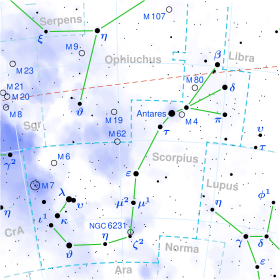V1073 Scorpii
Appearance
| Observation data Epoch J2000.0 Equinox J2000.0 | |
|---|---|
| Constellation | Scorpius |
| Right ascension | 17h 04m 49.35227s[1] |
| Declination | −34° 07′ 22.5483″[1] |
| Apparent magnitude (V) | +4.87[2] |
| Characteristics | |
| Spectral type | B0.7 Ia[3] |
| U−B color index | −0.69[2] |
| B−V color index | +0.26[2] |
| Variable type | α Cyg[4] |
| Astrometry | |
| Radial velocity (Rv) | 7.00[5] km/s |
| Proper motion (μ) | RA: −1.60 ± 0.33[1] mas/yr Dec.: −3.28 ± 0.23[1] mas/yr |
| Parallax (π) | 0.70 ± 0.29 mas[1] |
| Distance | 2,510[6] pc |
| Absolute magnitude (MV) | −6.8[7] |
| Details | |
| Mass | 23[8] M☉ |
| Radius | 36.0[7] R☉ |
| Luminosity | 302,000[7] L☉ |
| Surface gravity (log g) | 2.70[8] cgs |
| Temperature | 22,500[7] K |
| Rotational velocity (v sin i) | 47[8] km/s |
| Age | 4.2[9] Myr |
| Other designations | |
| Database references | |
| SIMBAD | data |
V1073 Scorpii (V1073 Sco) is a variable star in the constellation Scorpius. It also has a non-Greek Bayer designation of k Scorpii.
V1073 Sco has a 14th magnitude companion.[10]
V1073 Sco is an α Cygni variable,[11] a supergiant which pulsates erratically on a timescale of days to weeks. The mean visual magnitude is 4.87 and its brightness changes at most by less than a tenth of a magnitude. A simplistic fitting of Hipparcos data suggests a periodicity of 1.6 days.[12][13]
V1073 Scorpii is a runaway star, moving at more than 37 km/s relative to its neighbourhood.[9] No bow shock has been detected.[14]
References
- ^ a b c d e van Leeuwen, F. (2007). "Validation of the new Hipparcos reduction". Astronomy and Astrophysics. 474 (2): 653–664. arXiv:0708.1752. Bibcode:2007A&A...474..653V. doi:10.1051/0004-6361:20078357.Vizier catalog entry
- ^ a b c Ducati, J. R. (2002). "VizieR Online Data Catalog: Catalogue of Stellar Photometry in Johnson's 11-color system". CDS/ADC Collection of Electronic Catalogues. 2237: 0. Bibcode:2002yCat.2237....0D.
- ^ Kraus, M.; Borges Fernandes, M.; Kubát, J. (2009). "Parameters of galactic early B supergiants. The influence of the wind on the interstellar extinction determination". Astronomy and Astrophysics. 499: 291. Bibcode:2009A&A...499..291K. doi:10.1051/0004-6361/200810319.
- ^ Samus, N. N.; Durlevich, O. V.; et al. (2009). "VizieR Online Data Catalog: General Catalogue of Variable Stars (Samus+ 2007-2013)". VizieR On-line Data Catalog: B/gcvs. Originally Published in: 2009yCat....102025S. 1. Bibcode:2009yCat....102025S.
- ^ Kharchenko, N. V.; Scholz, R.-D.; Piskunov, A. E.; Röser, S.; Schilbach, E. (2007). "Astrophysical supplements to the ASCC-2.5: Ia. Radial velocities of ˜55000 stars and mean radial velocities of 516 Galactic open clusters and associations". Astronomische Nachrichten. 328 (9): 889. arXiv:0705.0878. Bibcode:2007AN....328..889K. doi:10.1002/asna.200710776.
- ^ Mel'Nik, A. M.; Efremov, Yu. N. (1995). "A new list of OB associations in our galaxy". Astronomy Letters. 21: 10. Bibcode:1995AstL...21...10M.
- ^ a b c d Crowther, P. A.; Lennon, D. J.; Walborn, N. R. (2006). "Physical parameters and wind properties of galactic early B supergiants". Astronomy and Astrophysics. 446: 279. arXiv:astro-ph/0509436. Bibcode:2006A&A...446..279C. doi:10.1051/0004-6361:20053685.
- ^ a b c Fraser, M.; Dufton, P. L.; Hunter, I.; Ryans, R. S. I. (2010). "Atmospheric parameters and rotational velocities for a sample of Galactic B-type supergiants". Monthly Notices of the Royal Astronomical Society. 404: 1306. arXiv:1001.3337. Bibcode:2010MNRAS.404.1306F. doi:10.1111/j.1365-2966.2010.16392.x.
{{cite journal}}: CS1 maint: unflagged free DOI (link) - ^ a b Tetzlaff, N.; Neuhäuser, R.; Hohle, M. M. (2011). "A catalogue of young runaway Hipparcos stars within 3 kpc from the Sun". Monthly Notices of the Royal Astronomical Society. 410: 190. arXiv:1007.4883. Bibcode:2011MNRAS.410..190T. doi:10.1111/j.1365-2966.2010.17434.x.
{{cite journal}}: CS1 maint: unflagged free DOI (link) - ^ Mason, Brian D.; Wycoff, Gary L.; Hartkopf, William I.; Douglass, Geoffrey G.; Worley, Charles E. (2001). "The 2001 US Naval Observatory Double Star CD-ROM. I. The Washington Double Star Catalog". The Astronomical Journal. 122 (6): 3466. Bibcode:2001AJ....122.3466M. doi:10.1086/323920.
- ^ Kazarovets, E. V.; Samus, N. N.; Durlevich, O. V.; Frolov, M. S.; Antipin, S. V.; Kireeva, N. N.; Pastukhova, E. N. (1999). "The 74th Special Name-list of Variable Stars". Information Bulletin on Variable Stars. 4659: 1. Bibcode:1999IBVS.4659....1K.
- ^ Koen, Chris; Eyer, Laurent (2002). "New periodic variables from the Hipparcos epoch photometry". Monthly Notices of the Royal Astronomical Society. 331: 45. arXiv:astro-ph/0112194. Bibcode:2002MNRAS.331...45K. doi:10.1046/j.1365-8711.2002.05150.x.
{{cite journal}}: CS1 maint: unflagged free DOI (link) - ^ Lefèvre, L.; Marchenko, S. V.; Moffat, A. F. J.; Acker, A. (2009). "A systematic study of variability among OB-stars based on HIPPARCOS photometry". Astronomy and Astrophysics. 507 (2): 1141. Bibcode:2009A&A...507.1141L. doi:10.1051/0004-6361/200912304.
- ^ Peri, C. S.; Benaglia, P.; Brookes, D. P.; Stevens, I. R.; Isequilla, N. L. (2012). "E-BOSS: An Extensive stellar BOw Shock Survey. I. Methods and first catalogue". Astronomy & Astrophysics. 538: A108. arXiv:1109.3689. Bibcode:2012A&A...538A.108P. doi:10.1051/0004-6361/201118116.

